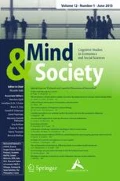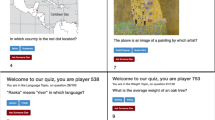Abstract
We propose using a bi-axial map as a heuristic for categorizing different dynamics involved in the relationship between quality and popularity. The east–west axis represents the degree to which an agent’s decision is influenced by those of other agents. This ranges from the extreme western edge, where an agent learns individually (no outside influence), to the extreme eastern edge, where an agent is influenced by a large number of other agents. The vertical axis represents how easy or difficult it is for an agent to discern the relative quality of available choices. When a case study is located on the map, it becomes easier to select the range of tools to use for understanding and predicting the relation between quality and popularity.

Similar content being viewed by others
References
Akerlof GA (1970) The market for “lemons”: quality uncertainty and the market mechanism. Quart J Econ 84:488–500
Asch SE (1955) Opinions and social pressure. Sci Am 193:31–35
Bass FM (1969) A new product growth model for consumer durables. Manage Sci 15:215–227
Beinhocker E (2007) The origin of wealth. Harvard Business School Press, Cambridge
Bentley RA (2008) Random drift versus selection in academic vocabulary. PLoS ONE 3(8):e3057
Bentley RA, O’Brien MJ (2011) The selectivity of social learning and the tempo of cultural evolution. J Evol Psych (in press)
Bentley RA, Ormerod P (2010) A rapid method for assessing social versus independent interest in health issues. Soc Sci Med 71:482–485
Bentley RA, Ormerod P, Batty M (2011) Social influence and evolving long-tailed distributions: bridges to ‘social physics’. Behav Ecol Sociobiol 65:537–546
Berger J, Le Mens G (2009) How adoption speed affects the abandonment of cultural tastes. Proc Natl Acad Sci 106:8146–8150
Bikhchandani S, Hirshleifer D, Welch I (1992) A theory of fads, fashion, custom, and cultural change as informational cascades. J Polit Econ 100:992–1026
Boyd R, Richerson PJ (1985) Culture and the evolutionary process. University of Chicago Press, Chicago
Boyd R, Gintis H, Bowles S (2010) Coordinated punishment of defectors sustains cooperation and can proliferate when rare. Science 328:617–620
Brock WA, Durlauf SN (2007) Identification of binary choice models with social interactions. J Econom 140:52–75
Brock WA, Durlauf SN (2010) Adoption curves and social interactions. J Eur Econ Assoc 8:232–251
Byers BE, Belinsky KL, Bentley RA (2010) Independent cultural evolution of two song traditions in the chestnut-sided warbler. Am Nat 176:476–489
Dunbar RIM, Shultz S (2007) Evolution in the social brain. Science 317:1344–1347
Ehrenberg ASC (1959) The pattern of consumer purchases. J Roy Stat Soc C 8:26–41
Eriksson K, Jansson F, Sjöstrand J (2010) Bentley’s conjecture on popularity toplist turnover under random copying. Ramanujan J 23:371–396
Frank SA (2009) The common patterns of nature. J Evol Biol 22:1563–1585
Goodhardt GJ, Ehrenberg ASC, Chatfield C (1984) The Dirichlet: a comprehensive model of buying behavior. J R Stat Soc A 147:621–655
Griliches Z (1957) Hybrid corn: an exploration in the economics of technological change. Econometrica 25:501–522
Hahn MW (2008) Toward a selection theory of molecular evolution. Evolution 62:255–265
Hahn MW, Bentley RA (2003) Drift as a mechanism for cultural change: an example from baby names. Proc R Soc B 270:S1–S4
Henrich J (2001) Cultural transmission and the diffusion of innovations. Am Anthropol 103:992–1013
Henrich J (2010) The evolution of innovation-enhancing institutions. In: O’Brien MJ, Shennan SJ (eds) Innovation in cultural systems: contributions from evolutionary anthropology. MIT Press, Cambridge, pp 99–120
Henrich J, Gil-White F (2001) The evolution of prestige: freely conferred deference as a mechanism for enhancing the benefits of cultural transmission. Evol Hum Behav 22:165–196
Herrmann E, Call J, Hare B, Tomasello M (2007) Humans have evolved specialized skills of social cognition: the cultural intelligence hypothesis. Science 317:1360–1366
Ijiri Y, Simon HA (1964) Business firm growth and size. Am Econ Rev 54:77–89
Kandler A, Laland KN (2009) An investigation of the relationship between innovation and cultural diversity. Theor Pop Biol 76:59–67
Keynes JM (1921) A treatise on probability. Macmillan, London
Keynes JM (1936) The general theory of employment, interest, and money. Macmillan, London
Kline M, Boyd R (2010) Population size predicts tool complexity in Oceania. Proc R Soc B 277:2559–2564
Knight FH (1921) Risk, uncertainty and profit. Houghton Mifflin, Boston
Laland KN (2004) Social learning strategies. Learn Behav 32:4–14
Laland KN, Odling-Smee J, Myles S (2010) How culture shaped the human genome: bringing genetics and the human sciences together. Nat Rev Genet 11:137–148
Lieberman E, Hauert C, Nowak MA (2005) Evolutionary dynamics on graphs. Nature 433:312–316
Lyman RL, VanPool TL, O’Brien MJ (2009) The diversity of North American projectile-point types, before and after the bow and arrow. J Anthropol Archaeol 28:1–13
Mesoudi A (2008) An experimental simulation of the “copy-successful-individuals” cultural learning strategy: adaptive landscapes, producer–scrounger dynamics, and informational access costs. Evol Hum Behav 29:350–363
Milgram S (1963) Behavioral study of obedience. J Abnorm Soc Psych 67:371–378
Milgrom P, Roberts J (1990) Rationalizability, learning, and equilibrium in games with strategic complementarities. Econometrica 58:1255–1277
Neiman FD (1995) Stylistic variation in evolutionary perspective: inferences from decorative diversity and interassemblage distance in Illinois Woodland ceramic assemblages. Am Antiquity 60:7–36
O’Brien MJ, Bentley RA (2011) Stimulated variation and cascades: two processes in the evolution of complex technological systems. J Arch Method Theo (in press)
Ohtsuki H, Hauert C, Lieberman E, Nowak MA (2006) A simple rule for the evolution of cooperation on graphs and social networks. Nature 441:502–505
Ormerod P, Colbaugh R (2006) Cascades of failure and extinction in evolving complex systems. J Artif Soc Soc Sim 9(4)9. http://jasss.soc.surrey.ac.uk/9/4/9.html
Ormerod P, Evans E (2011) Ex ante prediction of cascade sizes on networks of agents facing binary outcomes. arXiv:1103.3457
Perrot A, Linnemer L (2000) Une analyse économique des “signes de qualité”: labels et certification des produits. Rev Écon 51:1397–1418
Powell A, Shennan S, Thomas MG (2009) Late Pleistocene demography and the appearance of modern human behavior. Science 324:1298–1301
Reali F, Griffiths TL (2009) Words as alleles: connecting language evolution with Bayesian learners to models of genetic drift. Proc R Soc B 277:429–436
Richerson PJ, Boyd R, Henrich J (2010) Gene–culture coevolution in the age of genomics. Proc Natl Acad Sci 107:8985–8992
Rogers EM (1962) Diffusion of innovations. Free Press, New York
Rogers A (1988) Does biology constrain culture? Am Anthropol 90:819–831
Salganik MJ, Dodds PS, Watts DJ (2006) Experimental study of inequality and unpredictability in an artificial cultural market. Science 311:854–856
Schiffer MB (2005) The devil is in the details: the cascade model of invention processes. Am Antiquity 70:485–502
Sela A, Berger J (2011) Decision quicksand: when trivial choices suck us in. SSRN. http://ssrn.com/abstract=1814168
von Hayek FA (1992) The pretense of knowledge. In: Lindbeck A (ed) Nobel lectures, economics 1969–1980. World Scientific, Singapore, pp 179–189
Watts DJ (2002) A simple model of global cascades on random networks. Proc Natl Acad Sci 99:5766–5771
Winterhalder B, Smith EA (2000) Analyzing adaptive strategies: human behavioral ecology at twenty-five. Evol Anthropol 9:51–72
Acknowledgments
We thank the Leverhulme Trust for its support of the Tipping Points program at Durham University, as well as the Institute of Advanced Study at Durham.
Author information
Authors and Affiliations
Corresponding author
Rights and permissions
About this article
Cite this article
Bentley, R.A., O’Brien, M.J. & Ormerod, P. Quality versus mere popularity: a conceptual map for understanding human behavior. Mind Soc 10, 181–191 (2011). https://doi.org/10.1007/s11299-011-0087-4
Received:
Accepted:
Published:
Issue Date:
DOI: https://doi.org/10.1007/s11299-011-0087-4




